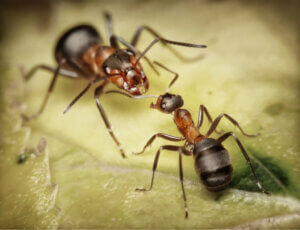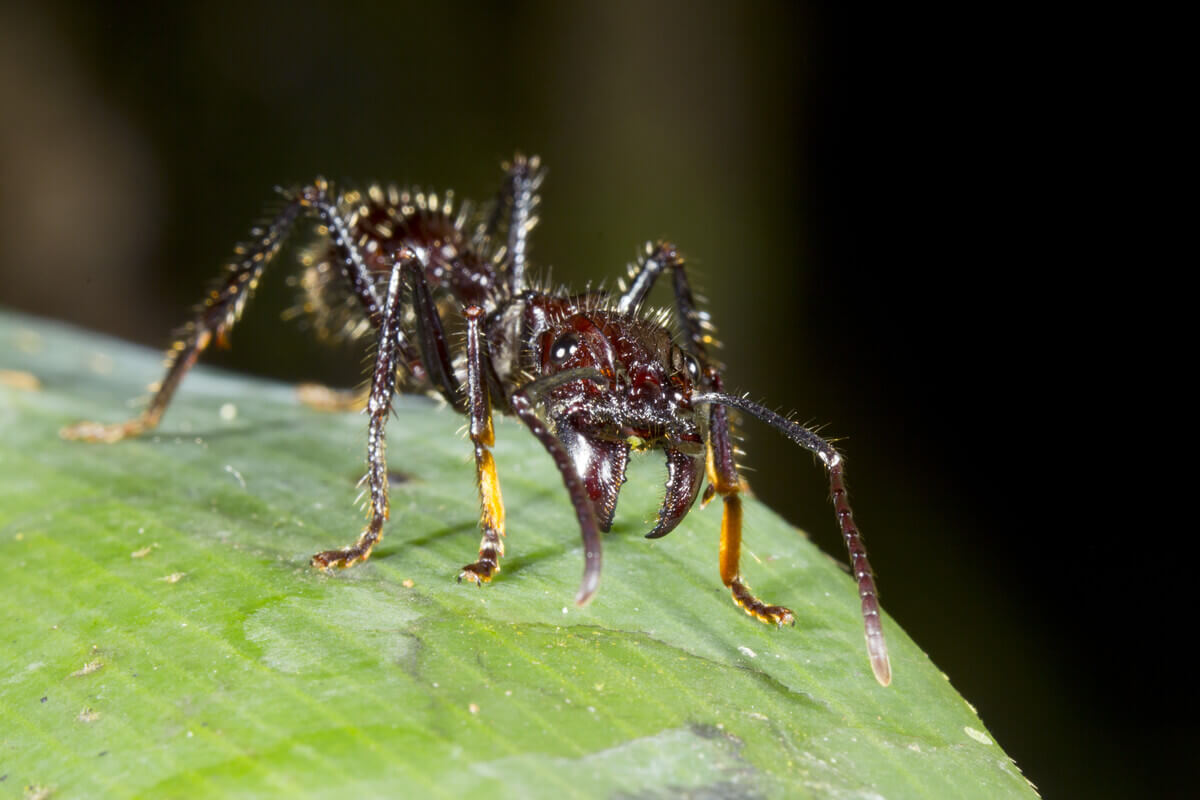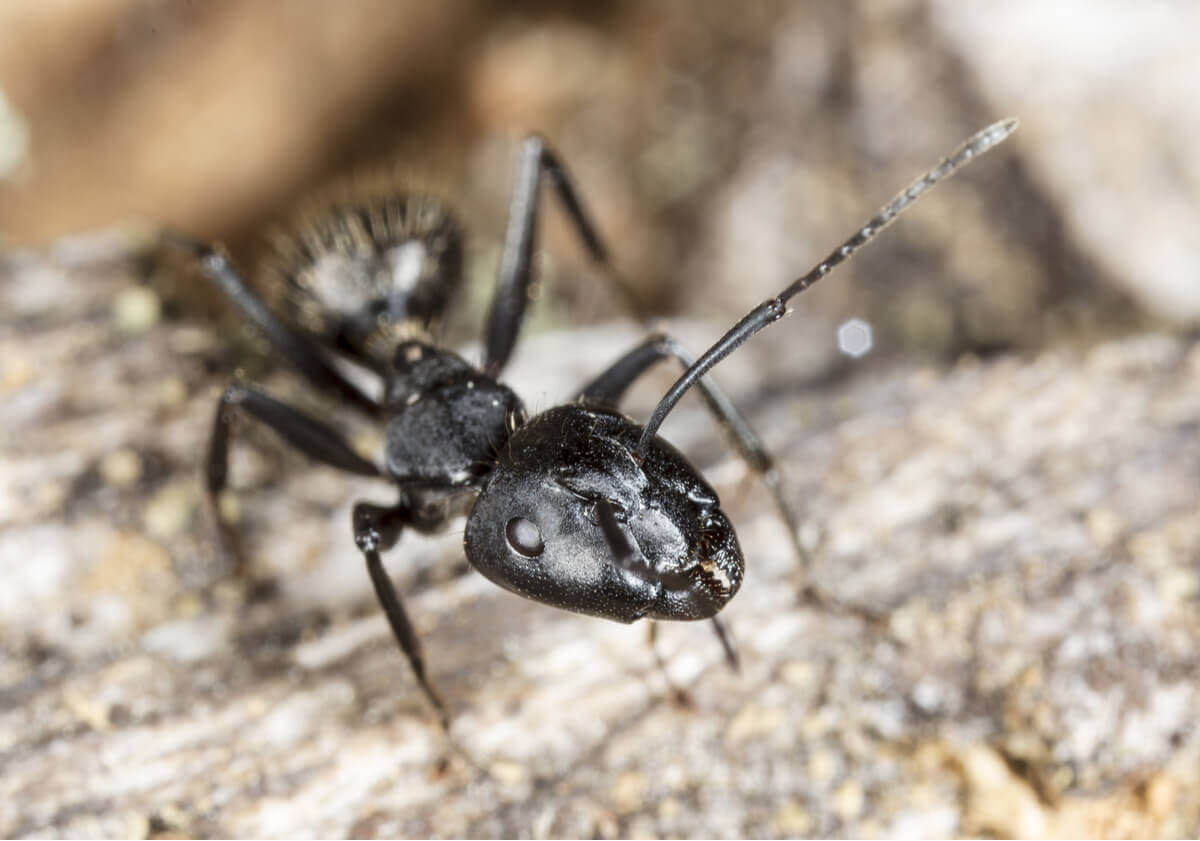5 Interesting Facts about Soldier Ants

Ants are a great example of an animal ‘society’. Each individual ant in the anthill has their own job to do and works as part of a team. The queen, soldier ants, worker ants, and nurse ants each perform a different role that’s vital for the colony’s survival.
Each ant is born with special characteristics that make it suited to its role. For example, soldier ants are generally more aggressive and will make frequent journeys to explore the area surrounding the anthill. Today, we’re going to look at solder ants in more detail and find out how they defend their territory.
Life in the anthill
Not all animals that live in groups form a true ‘society’. In fact, this only happens with certain species, like ants, bees, wasps, termites, or the naked mole-rat. In the case of ants, they divide into two different groups, fertile and infertile, which consist of the following roles:
- The queen
- Workers and soldiers
- Fertile males
Workers and soldiers are infertile and dedicate themselves to building and protecting the anthill, supplying food, and caring for the larvae. Meanwhile, the queen is in charge of reproduction and is the center of the whole society.
Soldier ants and their fascinating characteristics
Soldier ants perform a vital role in keeping the anthill safe. They protect the queen, defend the colony, kill prey, attack enemy colonies in search of food or materials, and even take the eggs of other colonies hostage.
There are many reasons to admire these insects and not just because of the way they defend their society. Here are five fascinating key traits of soldier ants.
1. Soldier ants are larger than worker ants
Soldier ants are bigger than their companions, and their heads and jaws are much wider and stronger to help them attack enemies.
In some ant species, the power of the soldier ant’s bite is truly amazing. For example, ants from the genus Odontomachus have faster jaws than any other predatory weapon in the animal kingdom.
Bullet ants (Paraponera) from Central and South America have the most painful sting of any insect, although it’s not fatal for humans. Some people who have been bitten by one have even compared it to being shot.

2. They treat their wounded in combat
When attacking other anthills, it’s very common for an ant to lose a limb, get injured, or get killed. But researchers have observed that wounded African Matabele ants (Megaponera analis) can make a call for help with a chemical signal. This causes other ants to come and help them and take them back to the nest.
The most fascinating thing about this is that the decision about who to save and who to leave isn’t made by the rescuers but by the wounded ants themselves. Once back in the anthill, healthy ants treat the wounded by ‘licking’ them intensely. It’s believed that their saliva contains antimicrobial substances that reduce the risk of infection.
3. Soldier ants can be “reprogrammed”
Despite their differences, the various types of ants share almost identical genes. This means that there are other epigenetic factors that influence their behavior, and furthermore, the assignment of their role in the anthill happens early in development.
A soldier ant can start behaving like a worker ant as the result of administering certain substances in the laboratory. But, this reprogramming can only be done for up to a maximum of five days after hatching.
4. One organ determines their role
The proportion of soldier and worker ants in the colony needs to be kept in balance and not all larvae produce a soldier ant.
The key difference seems to be a vestigial organ that appears during the final stages of development. These are the imaginal wing discs which, in queens and fertile males, give rise to wings in later development.
Although worker and soldier ants don’t have wings, they do briefly appear during early development and are an important part of regulating the proportions between the head and body of the soldier ants.
If this group of cells is modified during the development stages, then their subsequent physical characteristics will also change.
And furthermore, the appearance of this organ is controlled by hormones depending on the needs of the colony. So, this means that there are external controls to make sure that there are enough soldier ants. Isn’t that amazing?
5. Soldier ants form real armies
Even outside the anthill, there’s still a division of labor. Soldier ants group together in real platoons and are highly organized. This way, they can maximize their chances of victory when faced with a threat.
A good example of this is the species Macrotermes natalensis. Before an attack, these ants transmit vibrations by hitting their heads against the ground to alert the other members of the group. The solder ants then rush to the ant sounding the alarm and the workers safely hide away the larvae and run to help the queen.

These are just five fascinating facts about soldier ants, but there are many, many more. The world of social insects is truly astonishing and never ceases to amaze.
Ants are a great example of an animal ‘society’. Each individual ant in the anthill has their own job to do and works as part of a team. The queen, soldier ants, worker ants, and nurse ants each perform a different role that’s vital for the colony’s survival.
Each ant is born with special characteristics that make it suited to its role. For example, soldier ants are generally more aggressive and will make frequent journeys to explore the area surrounding the anthill. Today, we’re going to look at solder ants in more detail and find out how they defend their territory.
Life in the anthill
Not all animals that live in groups form a true ‘society’. In fact, this only happens with certain species, like ants, bees, wasps, termites, or the naked mole-rat. In the case of ants, they divide into two different groups, fertile and infertile, which consist of the following roles:
- The queen
- Workers and soldiers
- Fertile males
Workers and soldiers are infertile and dedicate themselves to building and protecting the anthill, supplying food, and caring for the larvae. Meanwhile, the queen is in charge of reproduction and is the center of the whole society.
Soldier ants and their fascinating characteristics
Soldier ants perform a vital role in keeping the anthill safe. They protect the queen, defend the colony, kill prey, attack enemy colonies in search of food or materials, and even take the eggs of other colonies hostage.
There are many reasons to admire these insects and not just because of the way they defend their society. Here are five fascinating key traits of soldier ants.
1. Soldier ants are larger than worker ants
Soldier ants are bigger than their companions, and their heads and jaws are much wider and stronger to help them attack enemies.
In some ant species, the power of the soldier ant’s bite is truly amazing. For example, ants from the genus Odontomachus have faster jaws than any other predatory weapon in the animal kingdom.
Bullet ants (Paraponera) from Central and South America have the most painful sting of any insect, although it’s not fatal for humans. Some people who have been bitten by one have even compared it to being shot.

2. They treat their wounded in combat
When attacking other anthills, it’s very common for an ant to lose a limb, get injured, or get killed. But researchers have observed that wounded African Matabele ants (Megaponera analis) can make a call for help with a chemical signal. This causes other ants to come and help them and take them back to the nest.
The most fascinating thing about this is that the decision about who to save and who to leave isn’t made by the rescuers but by the wounded ants themselves. Once back in the anthill, healthy ants treat the wounded by ‘licking’ them intensely. It’s believed that their saliva contains antimicrobial substances that reduce the risk of infection.
3. Soldier ants can be “reprogrammed”
Despite their differences, the various types of ants share almost identical genes. This means that there are other epigenetic factors that influence their behavior, and furthermore, the assignment of their role in the anthill happens early in development.
A soldier ant can start behaving like a worker ant as the result of administering certain substances in the laboratory. But, this reprogramming can only be done for up to a maximum of five days after hatching.
4. One organ determines their role
The proportion of soldier and worker ants in the colony needs to be kept in balance and not all larvae produce a soldier ant.
The key difference seems to be a vestigial organ that appears during the final stages of development. These are the imaginal wing discs which, in queens and fertile males, give rise to wings in later development.
Although worker and soldier ants don’t have wings, they do briefly appear during early development and are an important part of regulating the proportions between the head and body of the soldier ants.
If this group of cells is modified during the development stages, then their subsequent physical characteristics will also change.
And furthermore, the appearance of this organ is controlled by hormones depending on the needs of the colony. So, this means that there are external controls to make sure that there are enough soldier ants. Isn’t that amazing?
5. Soldier ants form real armies
Even outside the anthill, there’s still a division of labor. Soldier ants group together in real platoons and are highly organized. This way, they can maximize their chances of victory when faced with a threat.
A good example of this is the species Macrotermes natalensis. Before an attack, these ants transmit vibrations by hitting their heads against the ground to alert the other members of the group. The solder ants then rush to the ant sounding the alarm and the workers safely hide away the larvae and run to help the queen.

These are just five fascinating facts about soldier ants, but there are many, many more. The world of social insects is truly astonishing and never ceases to amaze.
All cited sources were thoroughly reviewed by our team to ensure their quality, reliability, currency, and validity. The bibliography of this article was considered reliable and of academic or scientific accuracy.
- hormigapedia.net
- Karl M. Glastad, Riley J. Graham, Linyang Ju, Julian Roessler, Cristina M. Brady, Shelley L. Berger,
Epigenetic Regulator CoREST Controls Social Behavior in Ants. Molecular Cell, Volume 77, Issue 2, 2020. - Frank, Erik Thomas and Schmitt, Thomas and Hovestadt, Thomas and Mitesser, Oliver and Stiegler, Jonas and Linsenmair, Karl Eduard. Saving the injured: Rescue behavior in the termite-hunting ant Megaponera analis.
2017. - Rajakumar, R., Koch, S., Couture, M. et al. Social regulation of a rudimentary organ generates complex worker-caste systems in ants. Nature 562,574–577 (2018).
This text is provided for informational purposes only and does not replace consultation with a professional. If in doubt, consult your specialist.








